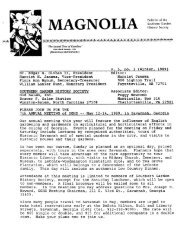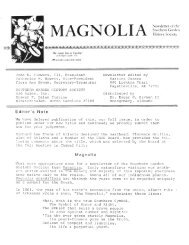Vol. XII, no. 2, 3 & 4 - Southern Garden History Society
Vol. XII, no. 2, 3 & 4 - Southern Garden History Society
Vol. XII, no. 2, 3 & 4 - Southern Garden History Society
You also want an ePaper? Increase the reach of your titles
YUMPU automatically turns print PDFs into web optimized ePapers that Google loves.
<strong>Society</strong> Visits<br />
Maryland's Eastern<br />
Shore for Annual<br />
Meeting<br />
by Kenneth M. McFarland, Hillsborough, Nort h<br />
Carolina<br />
A magnificent eighteenth-century gree n<br />
house (orangery), houses redolent of English<br />
Palladianism, and breathtaking Eastern Shor e<br />
landscapes were but some of the feature s<br />
attracting members of the <strong>Southern</strong> Garde n<br />
<strong>History</strong> <strong>Society</strong> to Maryland for our fourteenth -<br />
annual meeting. Ed and Nan Shull, with th e<br />
invaluable assistance of such k<strong>no</strong>wledgeabl e<br />
local residents as Georgia Adler, worked literall y<br />
for years to organize the event, but their effort s<br />
more than paid off in a function that maintaine d<br />
in every way the reputation for excellence tha t<br />
hallmarks the <strong>Society</strong>'s yearly gatherings . (<strong>Society</strong><br />
members who attended the 1985 Annapoli s<br />
meeting may recall the exhibit set up in Easton<br />
by Ms. Adler, then director of the Historical<br />
<strong>Society</strong> of Talbot County, called "The Art of<br />
<strong>Garden</strong>ing: Maryland Landscapes and the<br />
American <strong>Garden</strong> Aesthetic, 1730-1930 .") Lending<br />
aid at every point too were members of the<br />
Historical <strong>Society</strong> of Talbot County whose office s<br />
and buildings in Easton provided both meetin g<br />
spaces and a staging point for the meeting activities .<br />
Ed Shull-the everhelpful conferenc<br />
e coordinator— protects Dean Norton from the impending storm .<br />
As has become the <strong>no</strong>rm for our annual<br />
meeting, those activities included an array o f<br />
formal presentations, tours, meals, and social<br />
functions . In the first category, member s<br />
attended sessions led by highly-respecte d<br />
garden historians, as well as leading<br />
authorities on the historic architecture an d<br />
landscapes of Maryland . Key<strong>no</strong>ting the event<br />
Friday after<strong>no</strong>on was Baltimore native Elea<strong>no</strong> r<br />
Weller, whose slides from the Archive of America n<br />
<strong>Garden</strong>s reminded members both of the wealth of<br />
visual material available at the Smithsonian and o f<br />
Ms. Weller's and Mac Griswold's seminal book The<br />
Golden Age of American <strong>Garden</strong>s . While Ms .<br />
Weller's talk was geographically wide ranging in<br />
its review of gardens and garden styles, the next<br />
speaker, Pete Lesher of the Chesapeake Bay<br />
Maritime Museum, reminded us of the wealth of<br />
history to be studied right in Easton and Talbot<br />
County — a point that subsequent tours more<br />
than supported .<br />
The evenings formal annual dinner at<br />
the Tidewater Inn included recognition of<br />
Flora Ann Bynum, whose years of tireless<br />
work as secretary-treasurer continues to be<br />
the backbone of our <strong>Society</strong>. Conferenc e<br />
coordinator Ed Shull then made a toast to<br />
ho<strong>no</strong>r the memory of St. Claire Wright of<br />
Annapolis. In his tribute to her major work<br />
in the restoration of the William Paca<br />
<strong>Garden</strong>s, Mr. Shull dedicated the entire<br />
annual meeting to "the wit and grit" of<br />
this outstanding lady .<br />
Friday's presentations, in turn, set the stag e<br />
for the next morning when a battery of speakers ,<br />
impressive by any standard, examined in detai l<br />
the buildings and their settings that compris e<br />
Maryland's historic cultural landscape . Gathering<br />
<strong>no</strong>w in Easton's restored Avalon Theatre ,<br />
members heard first from Orlando Rideout o f<br />
the Maryland Historic Trust . Beginning with pre -<br />
contact Native American habitation practices and<br />
continuing on into the railroad age, Mr . Rideout<br />
scrutinized the interaction between peoples and<br />
landscapes that had shaped the appearance o f<br />
first the Maryland countryside and later the<br />
region's towns and cities . Peter Kurtze, also o f<br />
the Maryland Historical Trust, then narrowed th e<br />
discussion to examine the range of buildings ,<br />
small and large, that typify Maryland's vernacula r<br />
and high-style architecture — and indeed settin g<br />
the stage for several of the sites to be toured<br />
later in the program. Fittingly, the morning' s<br />
presentations then concluded with Barbara Well s<br />
7
















